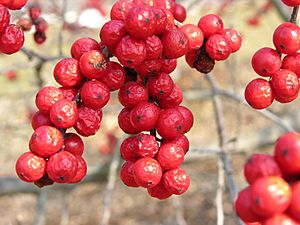Winterberry facts for kids
Quick facts for kids Winterberry |
|
|---|---|
 |
|
| Fruit in winter | |
| Conservation status | |
| Scientific classification | |
| Genus: |
Ilex
|
| Species: |
verticillata
|
 |
|
| Natural range | |
The winterberry (scientific name: Ilex verticillata) is a special type of holly plant. It grows naturally in eastern North America, including parts of the United States and southeast Canada. You can find it from Newfoundland all the way west to Ontario and Minnesota, and south to Alabama.
People also call this plant by other names, like black alder or Michigan holly. It often grows in wet places, such as wetlands. However, it can also be found on dry sand dunes and in grassy areas. The bright red berries of the winterberry are an important food source for many birds, including the American robin.
Contents
What Does the Winterberry Look Like?
The winterberry is a shrub that can grow to be about 3 to 16 feet (1 to 5 meters) tall. Unlike many other hollies, the winterberry is a deciduous plant. This means it loses all its leaves in the fall, just like many trees do.
In wet areas, the winterberry can spread out and form a thick group of plants. But in dry soil, it stays as a neat, compact shrub. Its leaves are shiny green and have jagged edges.
Flowers and Fruit
The flowers of the winterberry are quite small, only about 0.2 inches (5 millimeters) across. They have five to eight white petals.
The most famous part of the winterberry is its fruit. These are small, round, red berries, about 0.2 to 0.3 inches (6 to 8 millimeters) wide. They often stay on the branches long into the winter. This is how the plant got its name, "winterberry"!
Like most hollies, the winterberry has separate male and female plants. This is called being dioecious. For the female plants to grow berries, a male plant must be nearby. The male plant provides the pollen needed for the female flowers to turn into fruit.
How People Use Winterberry
Winterberry plants are quite useful and beautiful!
Traditional Uses
Long ago, Native American people used the berries of the winterberry for traditional purposes. They sometimes called it "fever bush."
It's important to know that the seeds, leaves, bark, and berries of this plant can make you feel sick if you eat them. They might cause nausea or lower your blood pressure. So, it's best not to eat them!
Growing Winterberry in Gardens
The winterberry is a very popular plant for gardens. People love it because its bright red berries add a splash of color in the middle of winter. Since the plant loses its leaves, the berries really stand out! This makes it a favorite even where other types of holly grow.
The bare branches covered in berries are also popular for making flower arrangements. They look beautiful in winter decorations.
Winterberry plants are easy to grow and don't usually get many diseases or pests. They grow best in wet, acidic soil, but they can also do well in a typical garden.
To make sure your female winterberry plants grow berries, you need to plant at least one male plant nearby. It's also important to pick male and female plants that flower at the same time. This way, the male plant can pollinate the female plant properly.
Popular Winterberry Varieties
There are many different types, or cultivars, of winterberry. They can differ in size, shape, and berry color.
Female Varieties (These grow berries!)
- Ilex verticillata 'Winter Red': This type has orange-red berries.
- Ilex verticillata 'Afterglow': This one also has orange-red berries.
- Ilex verticillata 'Red Sprite': Known for its large, red berries.
- Ilex verticillata 'Spravy' ("Berry Heavy"): This variety produces many orange-red berries.
- Ilex verticillata 'Spriber' ("Berry Nice"): This type has bright red berries.
Male Varieties (These help make berries, but don't grow them themselves!)
- Ilex verticillata 'Southern Gentleman'
- Ilex verticillata 'Jim Dandy'





